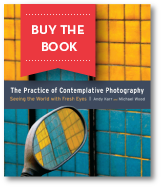black and white photography
I noticed at the beginning of your book you give credit to past masters, Andre Kertez and Henri Cartier-Bresson. To my way of thinking their approach to making pictures was often the same as Miksang yet black and white is not allowed in the on-line Miksang sites...only color. Isn't Miksang "a way" of approaching seeing and photographing the world rather than a "look?" Bryan Grigsby
Thanks for your comment Bryan. I completely agree that the intention of Andre Kertez, Henri Cartier-Bresson, and the other masters illustrated in The Practice of Contemplative Photography is the same as our approach. They shot in black and white because that was the technology of the day.
Today, using black and white is not just forming the equivelent of perceptions, it is adding an esthetic overlay. Black and white shots aren't really prohibited on this site, but they do have to clear a higher bar.
- Login to post comments


Comments
I'm agreeing with Andy & Michael here. I have been doing photography for 35 some years and in the beginning nearly exclusively with black and white film. When I take a photograph I generally know at the instant I see an image whether I am going to use it as a color or b&w photograph. I see the two differently and rarely decide to "use" both color and black & white images as end products. Perhaps this was training but it is instinctive and automatic now. So, yes, I physically see in color and shoot digital in color but I may very well perceive b&w in my mind's eye with out really thinking about it. Color is the natural way we see as humans, but think of the eyes as tools as well as a camera. Bees see into the UV portion of the spectrum, most mammals in (near) b&w. So would the pure non-conceptual seeing of a cat be invalid simply because they perceive differently? Yes, I know cats are not artists.
So I often see something that catches my eye and just shoot it as is but know it will be b&w. Now if I take an image perceived in color but later decide to experiment with it in b&w I will not be using that version as a true Contemplative image. The manipulation then becomes conceptual. You have to stay honest with yourself. I am rather new to Contemplative or Miksang photography, about two months into it. I just completed a class in it. But I have been taking these types of images for decades but just did not know it had a name. So far I tend to toggle between conceptual and perceptual modes rapidly, too rapidly. I probably need to relax more and try to stay in a perceptive state longer to notice and see in this "new" way more. That is try not to shoot both perceptive and conceptual photographs in the same day. In addition to being an advanced amateur photographer I am also a biologist so some of my rhetoric may get awkward. Science and art can be strange bed fellows at times (usually not for me, but my vocabulary my reflect my technical training). Perhaps surprisingly, the science, engineer, math, and technical people in my class seems to catch on to Contemplative photography faster than the art and feeling people. Andy, Michael, any comment or experience with that?
I'm not sure I agree here. Even when Kertez and Cartier-Bresson were shooting in B/W, their perception of what they were seeing was still in color (though they could probably visualize them in their 'mind's eye' as monochromatic images); so, in a sense, they too were add an "esthetic overlay" though one imposed by the technology they were using.
To take another tact, what if someone were to come to a miksang workshop with a B/W film camera, would one then say they would not be able to learn to see directly? And wouldn't that be imposing a false restriction of sorts on who can see clearly and who can't?
Regards, David
Thanks. You are right. Black and white does alter the scene in a way that color does not, although I think color is not a completely faithful witness to what the mind sees either...which to my way of thinking is pretty cool. Like Garry Winogrand said, " I photograph things to see how they look photographed."